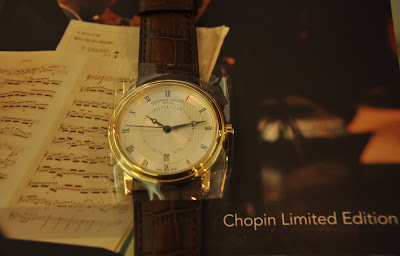 Specifications:
Specifications:Dial: White Dial. Date Display.
Glass: Convex Sapphire
Classical hour and minute hands
Case: Stainless Steel Gold plated
Crown: Signed 2-O-Rings Crown.
Approx. Case Size: 40 mm
Band: Brown Leather Strap
Buckle: Signed
Movement: Automatic (Caliber: FC-303, 25 Jewels, 38 h Power Reserve)
Water Resistance: 60 M / 6 Bar
Limited edition no. 497 out of 1810 pieces worldwide
Affordable luxury stylish watch at only RM 6,251 before my best price. Call me at 010-3010018 for the best possible price.
Guaranteed authentic with serial number. The new watch comes with original Frederique Constant outer and and miniature piano-like inner box, warranty certificate and manual.
Short History of Chopin
Frédéric-François Chopin (March 1, 1810 – October 17, 1849) is widely seen as one of the greatest Polish composers renowned for his piano works. A great Romantic composer, who nevertheless wrote absolute music with formal titles such as Mazurkas, Impromptus, Walzes, Nocturnes. He was another one of the extremely rare child prodigies.
The musical talent of young maestro was apparent when att the age of 7, he was already the author of two polonaises (in G minor and B-flat major), the first being published in the engraving workshop of Father Cybulski.
The prodigy was featured in the Warsaw newspapers, and 'little Chopin' became instant attraction at receptions given in the aristocratic salons of the capital. He also performed public charity concerts. His first professional piano lessons lasted only six years from 1816 to 1822, when his skills surpassed that of his teacher.

Chopin's music for the piano combined a unique rhythmic sense (particularly his use of rubato, chromatic inflections, and the style of Johann Sebastian Bach), as well as a piano technique, which was of his own creation.
This arrangement produced a particularly fragile sound in the melody and the harmony, which are nonetheless underpinned by solid and interesting harmonic techniques. He took the new salon genre of the nocturne, invented by Irish composer John Field, to a deeper level of sophistication, and endowed popular dance forms, such as the Polish mazurka and the Viennese waltz with a greater range of melody and expression.
(Taken from Frederique Constant's website)





























No comments:
Post a Comment